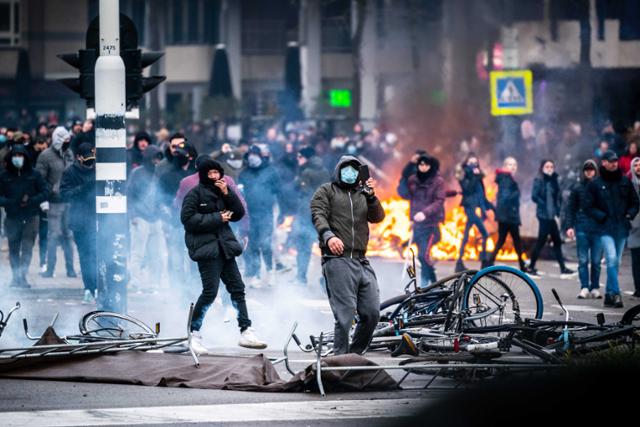
Protesters against the blockade, which occupied the streets of Eindhoven in the Netherlands on January 24, are fiercely resisting the police, setting fires on the roads. Eindhoven=EPA Yonhap News
Earlier this year, radical protests followed in the Netherlands. Citizens threw Molotov cocktails and stones, and set fire to a new coronavirus infection (Corona 19) test center. The police also mobilized water cannons and tear gas to disperse them. It wasn’t just the capital Amsterdam. Protests spread across the country, including The Hague, Rotterdam and Eindhoven.
It was because of dissatisfaction with the government’s quarantine. Citizens who came to the streets thought that the result of the inability to start vaccination later than the neighboring countries was to strengthen control. The Fuse Line was a curfew at night that began on January 17th. Going out was banned from 9 pm to 4:30 am the next day. It was the first time in the Netherlands after World War II.
Naturally, Prime Minister Mark Ruther’s reappointment seemed to be overkill. The January childcare subsidy scandal ignited, and the cabinet resigned. Until the general election on the 15th (local time), the role of the cabinet was the administration of the administration.

Prime Minister Mark Ruther is smiling brightly at the news of an exit investigation that the Liberal Democratic Party, led by him, will take the most seats on the 17th. The Hague = Reuters Yonhap News
However, the result was surprising. The Liberal Democratic Party (VVD), led by Prime Minister Luther, is expected to become the first party in the park by taking the most seats in the general election held for three days until the 17th. It is expected as of 9 a.m., when 63% of the seats are counted, that 35 of the 150 seats will be taken. The second place is likely to be the Progressive Democratic Party (D66) with 24 seats, and the Far Right Liberal Party (PVV) with 17 seats in third place. If the formation of a coalition government is successful, Prime Minister Ruther will be inaugurated as Dutch Prime Minister for the fourth time. The record of the longest-running prime minister also follows.
What is the secret? The Netherlands is a multi-party country where several political parties coexist. The general election is held with 100% proportional representation. Voters vote for the party they support, and each party divides the seats according to the rate of vote. If you record 0.6% or more of the vote, you can get at least one seat. It is a structure that makes it easy for minority parties to get seats.
It is not easy for a strong alternative force to emerge among the parties competing for the high number of seats. In this general election alone, there were a whopping 37 political parties. It was an advantageous composition for Prime Minister Luther. It is expected that 17 political parties will enter the hospital. None of them was outstanding.
As Prime Minister Ruther’s leadership was reaffirmed as he was re-credited in a general election in the form of a “popular vote,” evaluating the government’s response to Corona 19. However, the formation of a majority (at least 76 seats) rowing is always a challenge. At least two parties must be persuaded. It took 225 days to establish a cabinet after the 2017 general election. Again, it could take months. Reuters analyzed that “the coalition negotiations are likely to be prolonged.”
Park Ji-young reporter [email protected]
News directly edited by the Hankook Ilbo can also be viewed on Naver.

